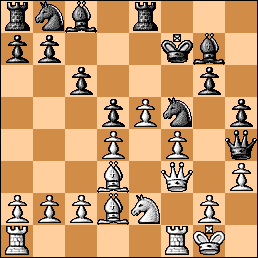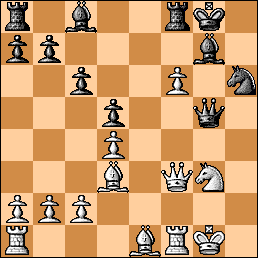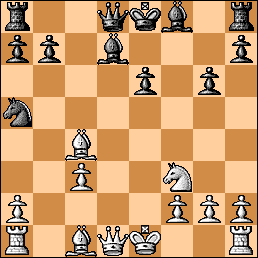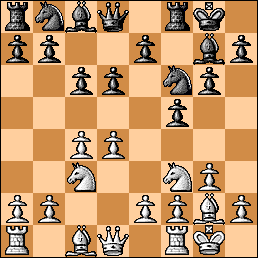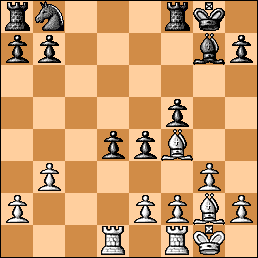For some reason, in the 1990s I was very interested in fighting the Dutch with unconventional weapons. Although this was, strictly speaking, completely unnecessary I present for your entertainment some of my jousts. I have now come to the conclusion that tried and true lines give white some edge vs Stonewall and Leningrad setups.
The first was from a New England Swiss. My opponent, Jack Young, deserves credit for co-creation of this bizarre king hunt.
IM Ginsburg – NM Jack Young, New England 199?
Dutch Defense, Sjödin Gambit
1. d4 e6 2. Nf3 f5 3. e4 fxe4 4. Ng5!?
The strange Sjödin Gambit (so named, as explained to me by GM Ferdinand Hellers, after a Swedish amateur player). Sjödin is a tough word to pronounce! It’s something like “Shuhhh-DEEN.” Joel Benjamin tried this move versus a Russian 2400+ and was successful, although his game was not without chances for black.
4…Nf6 5. f3

5…exf3 Black must seriously consider 5…h6 6. Nh3, one of the main alternatives to drive the menacing WN offside. In addition, I think Joel’s opponent played 5…c5!? to challenge the dark squares and got a good game; the trick is 6. fxe4 cxd4 7. e5?? Qa5+! picking up the e5-pawn.
6. Qxf3 Nc6 7. Bd3?
7. c3 was circumspect. The wild text move is unsound. But if it had not been played, we wouldn’t have the following (possibly unique? – see below) crazy game. Them’s the breaks.
7…Nxd4 Of course. If your opponent hangs center pawns, take them.
8. Qh3 d5! Refuting white’s coffeehouse antics.
9. Nxh7 Nxh7 10. Bxh7 Nxc2+ 11. Ke2 Kd7!

Very convincing. White has very few resources left.
12. Rf1 Nxa1 13. Rf7+ Kc6?! A fairly easy win is 13…Be7 14. Bg5 Re8 15. Qc3 b6 and white runs out of steam. Black is still winning after the text, but he’ll need to find a tough move shortly.
14. Qc3+ Kb6 15. Be3+ c5 16. b4 At least white is making a little trouble now. The game is starting to take on very strange overtones. Watch the black king double back now and head into the center!

16…d4?
Finally black goes wrong. The difficult deflection, using a ‘doomed piece’, 16…Nb3!! still wins. For example, 17. axb3 d4! and white doesn’t have the b2 queen check as in the game. Or, 17. Qxb3 Bd7 18. bxc5++ Kc7 and black wins as well.
17. bxc5+ Bxc5 18. Qb2+ Kc6 19. Nc3? Too fancy, I was carried away. Correct is 19. Be4+! Kd6 20. Bxd4 and white wins.
19…Qb6? 19…dxc3 loses simply to 20. Be4+ Kd6 21. Bxc5+ Kxc5 22. Qxc3+ Kb6 23. Qb4+ Ka6 24. Rxb7 and mates. Black needed to play 19…a6! to take b5 away from white. For example, 20. Be4+ Kd6 21. Bf4+ e5 and there’s nothing more white can do. Now white is back on track again.
20. Be4+ Kd6 21. Nb5+ Ke5 22. Bf3!

Black’s king finds himself in a really bizarre mating net. His attempts to avoid it just lead the game into more and more surrealistic situations without changing the verdict: black’s king is trapped and cannot wriggle free. Enjoy this sideline: 22. Kd3! Rh4 23. Bf2 Rf4 24. Bg3 g5 25. Bxf4+ gxf4 26. Bc6!! (protecting the N on b5 temporarily is an important point)

Position after 26. Bc6!! (Analysis)
26…Qxc6 27. Qe2+ Kd5 28. Qe4 mate!
Or this, even more amusing: 22. Kd3! Rh4 23. Bf2 Rxe4 24. Kc4!!! and mate is forced in 10 moves! It’s really strange to have both kings participating in the center in the middlegame, with one king sealing the mating net on the other. Perhaps it’s unique in the history of chess!?? (readers??) Can you imagine this game played in the 19th century and some bearded fellow such as Steinitz announcing Mate in 10 in a grovelly voice?

Position after 24. Kc4!!! (Analysis) – Unique Tableau?
Here’s one of the shorter mates from this position: 24…g5 25. Bg3+ Rf4 26. Qe2 mate.
22…Rh4 23. g4! Caveman chess, brutally effective. White doesn’t need his queen anymore.
23…g5 24. Bxg5 Rxh2+ 25. Kd1 Rxb2 26. Bf4 mate
Not quite a pure mate; the N on b5 is not needed (guarding d6 twice).

It’s always nice to end a game with a queen sacrifice. This game was really way out there in deep orbit. It doesn’t stand up to serious analysis, but it did produce some unique situations.
1-0
The second took place at the Manhattan CC FIDE International Round-Robin, in the very first round of a Category X event. It should be noted that Mr. Fishbein overcame this reverse to score a GM norm! Veteran GM Yefim Geller played as well, along with Wojtkiewicz, Kaidonov, Bykhovsky, Sherzer, and others.
Mark Ginsburg – Alexander Fishbein (2470) MCC Int’l 2000.
Dutch Defense, 4. Bf4 gambit line
1. d4 f5 2. Nc3 d5 3. e4!? dxe4 4. Bf4 Sort of a cousin to the Sjodin.

White plans to simply play f2-f3 and leave black with a sick pawn formation.
4…Nf6 5. Bc4 Quite possible is 5. f3 exf3 (5… e6 6. fxe4 fxe4 7. Bc4 Bd6 8. Nge2 O-O 9. O-O Nc6! 10. a3! and white has some compensation) 6. Nxf3 e6 7. Bc4 Bd6 8. Bg5 c6 9. Qd3 b5 10. Bb3 Na6 and now we follow a chaotic old James Tarjan game. (10… b4 11. Ne2 Qc7 12. Bxf6 gxf6 13. O-O-O with compensation) 11. a3 Nc7 12. O-O h6 13. Bh4 g5 14. Rae1? Unsound. 14. Bf2 is fine. 14… gxh4 15. Qxf5 Qe7 (15… Rg8 16. Nxh4 Be7 17. Qf2 Rg7) 16. Qg6+ Kd8 17. Ne5 Bxe5 18. dxe5 Nfd5 (18… Nd7 19. Ne4 (19.Rf7 Qg5 20. Qe4 Nd5) 19… Nd5 20. Bxd5 cxd5 21. Nd6 Rf8 22. Rxf8+ Nxf8 23. Qxh6 Kc7 24. Nxb5+ Kb8 and white is a bit better) 19. Rf7? (19. Ne4! with a huge edge) 19… Qg5 20. Qd3 Rg8 21. Qf3 h3 (21… Nxc3 22. bxc3 (22. Qxc6 N3d5 23. Bxd5 Nxd5 24. Rf2 Nb6 25. Rd1+ Ke7 26. Qd6+ Ke8 27. Qc6+ Bd7 28. Rxd7 Nxd7 29. Qxa8+ Ke7) 22… Nd5 and black wins) 22. g3 Qd2 23. Re2 Qc1+ Now black should win. 24. Kf2 Qg5? (24… Bd7 wins) 25. Ne4! Qxe5 26. c3 Ne7? (26… Rg6 is fine for black) 27. Qd3+? (27. Nf6 is much better for white ) 27… Ncd5 28. Nf6 Qd6 29. Nxg8 Nxg8 30. Qh7 Nge7 31. Qxh6 Bd7?? A losing blunder. 31… Kc7 32. Qxh3 Kb8 33. Qh5 Nf5 34. Qh8 is equal. 32. Bxd5 Nxd5 33. Rf8+ Be8 34. Rxe8+ and it turns out white had the last laugh – 1-0 Tarjan,J-Gutierrez,J/Bogota 1979
5… e6 6. Nge2 Bd6 6… Nd5!? is interesting here. 7. O-O Be7 8. f3 Nxf4 9. Nxf4 is about equal.
7. O-O O-O Black can try to delay castling: 7… Nc6 8. Bxd6 cxd6 9. d5 Ne5 10. Bb3 exd5 11. Nxd5 Be6 12. Nef4 Bxd5 13. Nxd5 and white has some compensation.
8. f3 exf3 Playable is 8… Nc6 9. fxe4 Nxe4 10. Nxe4 fxe4 11. Qd2 Na5 12. Bb5 Bxf4 13.Rxf4! Rxf4 14. Qxf4 with good compensation.
9. Rxf3 Kh8 10. Qd2 Nc6 11. Rd1 Re8 12. Bg5 Be7 Although it looks dangerous, 12…e5 was quite playable here.
13. Rh3 e5 14. Qe1!? At the time, I thought I was doing quite well with this ‘attacking retreat’. However, black does have a good move here, which Fishbein failed to find.

14…Ng4?
This was the key moment. 14… Nxd4?? is very weak due to 15. Nxd4 Bc5 (15… exd4 16. Qh4 h6 17. Bxh6 Ng4 18. Bxg7+ Kxg7 19. Qh7+ wins) 16. Qh4 Bxd4+ 17. Kh1 Qd7 18. Nd5 and wins. The right move was 14… Ne4! 15. Nxe4 (15. Qh4? Nxg5 ) 15..fxe4 16. Bxe7 (16. Rxh7+ Kxh7 17. Qh4+ Kg6 does not work) Qxe7 and black stands better, having gotten out of the potentially annoying d-file attack by the white rook.
15. Qh4! White is much better now. Maybe black missed this simple move.
15…h6 16. dxe5 Bxg5? This is hopeless. 16… Bd7 17. Bxe7 Qxe7 18. Qxe7 Rxe7 19. Nf4 is terrible for black but still better than the text.
17. Rxd8 Bxd8 18. Qh5 Rf8 19. e6 Nce5 20. Nf4 From now on, there are numerous wins. White chose the primitive path of eating the most dangerous black pieces.
20…Kh7 21. Be2 Most effective is 21. Bd3! g5 22. Ncd5 Kg7 23. e7 Bxe7 24. Nxe7 gxf4 25. Nxf5+ Rxf5 26. Bxf5 Bxf5 27. Qxf5 Rf8 28. Qe4 and wins.
21… Be7 22. Ncd5 g6 23. Nxg6 Rather crude, but it works Black’s protection of h6 gets overloaded.

22… Bc5+ 24. Ne3 Bxe6 24… Nxg6 25. Bxg4 Bxe3+ 26. Rxe3 fxg4 27. Qxg4 wins.
25. Nxe5 Rf6 No better is 25…Bxe3+ 26. Rxe3 Nxe3 27. Qg6+ Kh8 28. Qxh6+ Kg8 29. Qxe6+ Kh7 30. Qg6+ Kh8 31. Qh6+ Kg8 32. Qxe3 and wins.
26. N5xg4 fxg4 27. Qxc5 Raf8 28. Bd3+
Black resigned. He is down hopeless amounts of material. 1-0
The crazy Dutch gambits didn’t always work out. Here’s a game from 1999 where I committed some miscues and went down in flames. Although, it must be admitted, I had my chances so we can’t dismiss the gambit line.
IM Ginsburg – IM Guillermo Rey
Arthur Dake International San Francisco 8/1999
Dutch Defense, Cousin of Sjodin Gambit
1.d4 f5 2.Nc3 d5 3.e4 dxe4 4.Bf4 Second time lucky?
4…Nf6 5.Bc4 e6 6.Nge2 Bd6 Rey passes up on 6…Nd5 just as Fishbein did.
7.0-0 0-0 8.f3 Nc6!
The knight definitely belongs here to eye the center. Remember Fishbein played 8….exf3 here. I wrote above that “8… Nc6 9. fxe4 Nxe4 10. Nxe4 fxe4 11. Qd2 Na5 12. Bb5 Bxf4 13.Rxf4! Rxf4 14. Qxf4 with good compensation.”
9.fxe4 fxe4 But Rey takes back with the pawn!
10.a3 Kh8 11.Ba2?
A weak move. 11. Bg5 is correct with decent compensation. For example, 11. Bg5 Be7 12. Qd2. White will be able to bypass ….e6-e5 with the response d4-d5.
11…e5! Of course. Black eliminates a weakness.
12.dxe5 Nxe5 13.Qe1?! 13. Qd4 is better.
13…Bd7 14.Bg5? 14. Kh1 or 14. Rd1 are better.
14…Neg4! 15.Nf4? White must “not have shown up that day.” This move simply loses. 15. h3 is correct.
15…Qe8 16.Qh4 Ne3?!
16…h6! is very strong here. White loses in all lines.
17.Nfd5 Nfxd5 18.Rxf8+ Bxf8 19.Nxd5 Nxd5 20.Bxd5 Bc6 21.Bc4 Qg6?
21…Bc5+ is much stronger and only after this, 22…Qg6. Black would win easily.
22.b4? This is also weak. 22. Be3, blockading, is correct. Then white can hold out some chance to save the game.
22…b5 23.Be2 h6 24.Be3 a5 25.bxa5 Rxa5 26.Rf1 Ra8 White has a ruined structure and cannot offer meaningful resistance.
27.Bh5 Qd6 28.Qf2 Be7 29.Bd4 Rf8 30.Qe3 Rxf1+ 31.Kxf1 Bf6 It is too much to hope for 31…Qxa3?? 32. Qxh6+ and mates.
32.Bxf6 Qxf6+ 33.Kg1 Qa1+ 34.Kf2 Qe5 35.Qh3 Qf4+ 36.Ke1 e3 37.Bf3 Be4 38.Qd7 Bxf3 39.gxf3 Qxf3 40.Qd8+ Kh7 41.Qd3+ Kg8 42.Qd8+ Qf8 43.Qd5+ Kh8 0-1
A very poorly played game with white committing blunders in every phase. C’est la vie!





